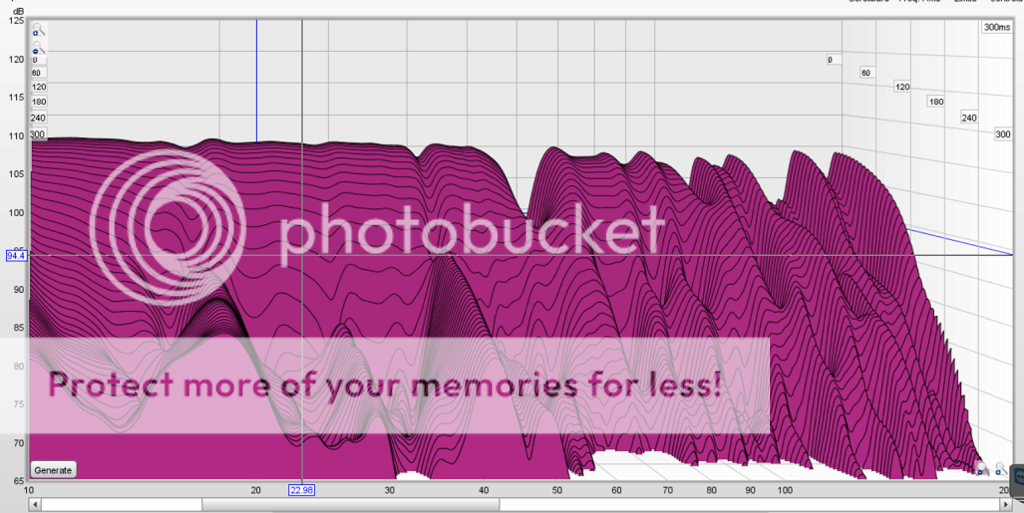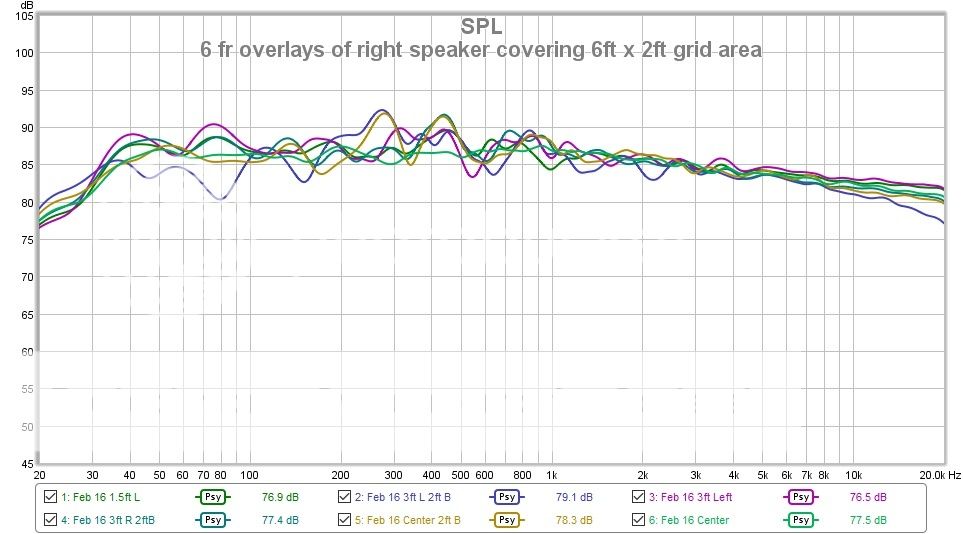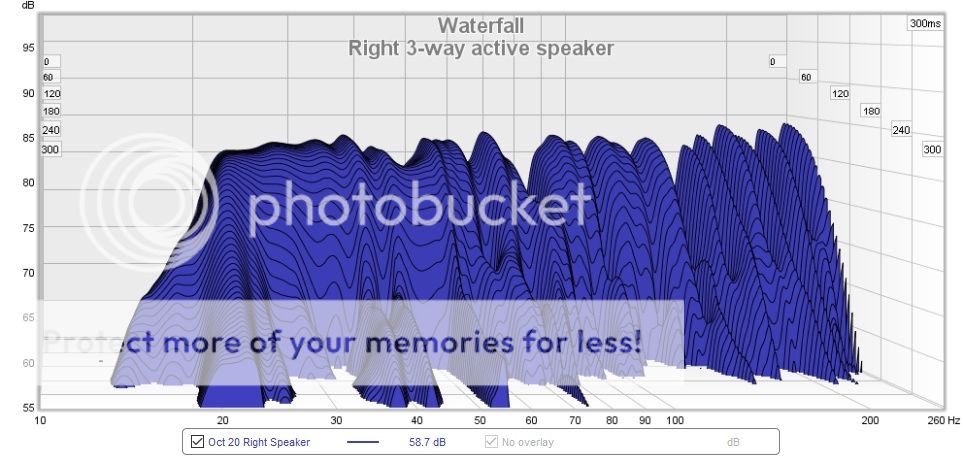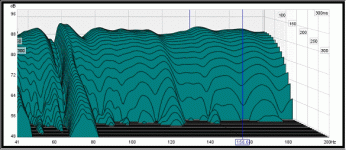Use EQ to remove the last bits of problems. you need to treat your room first, then apply small EQ.Can you really alter the modal behaviour of a domestic-sized room significantly with practical acoustic treatments? Multiple subs with DSP EQ and delay give the user a great deal of power and flexibility to attenuate peaks created by a room's modes. Wouldn't this have the effect of improving the time domain performance? By putting less energy into modal 'peaks' by multiple sub averaging and the use of DSP, the FR in the bass is flattened, but energy over time will also be reduced.
https://www.gearslutz.com/board/so-much-gear-so-little-time/48203-eqs-tuning-room.html
https://www.gearslutz.com/board/studio-building-acoustics/71846-compensating-room-acoustic-eq.html
https://www.gearslutz.com/board/stu...m-treatment-start-acoustic-corrective-eq.html
Yes, treatment will really help for modal problems in room.
EQ cannot solve a room problem. its not the speaker the problem, but the room. EQ will not make a room problem disapear.
<<Considering you are not fixing the monitors but fixing the room it only makes sense to fix the problem, which is the room. No amount of EQ will solve a room problem. It might lower a peak here or there but will do very little to nothing about the decay times, which decay times are just as important (IMO more important) then a flat response.
About decay times:
Waterfall Graphs
Before we move on to your next set of tests, here is a little background on decay times and waterfall graphs and why they are so important to view (if not more important then frequency response). As a sound plays through your speakers it doesn't just get to you and stop but continues to bounce around the room and slowly fades away over time. This is sometimes referred to by others as ringing or reverb. A waterfall graph allows you to visualize how quickly or slowly a given frequency decays over time.
Low frequencies tend to be stronger and stay more intense longer than higher frequencies. Higher frequencies are also easier to control. Things like people, furniture, carpet, curtains, and even air tend to have a much more significant impact on the higher frequencies than lower ones. In addition, high frequencies are much more directional where low frequencies tend to spread like a sphere in 3 dimensions. In a bare room, there really isn't much that has any significant impact on low frequencies which is why it is critical to have proper bass trapping . As the low end keeps bouncing around the room there are other things that you are trying to hear but the frequencies that are ringing are masking imaging cues, harmonic textures, and even cancelling and/or reinforcing themselves.
When someone refers to a room that sounds "tight" or "clear" they are most likely in a room that the low end decay times are under control with bass traps.>>
Subwoofer will not come anywhere close to bring the decay times of LF close to any minimal requirements (ie: -10 to -15db at 15ms at the listening position)Dr Geddes' presentation linked in post 20 makes the link expliçit between steady state modal room response and decay. Attenuating the drive signal to the subs at frequencies where there are high Q modes will improve (ie reduce) decay times down to any arbitary level, as well as flattening the FR.
Smoothing the FR may be a benefit of multiple subwoofer, but decay times are as important if not more when it comes to bass performance in rooms. any subwoofer do very little to reduce decay times.
<<A single FR graph is close to completely useless. Learn how to make readable frequency/amplitude/time –plots (like waterfall for instance) and also familiarise yourself with the “ETC”. These tools are far more revealing than a simple frequency response graph.>>
Last edited:
None of that directly contradicts the assertion that attenuating the energy the sub, or multiple sub system, is putting into modal peaks by definition reduces decay times. Again, how much effect will practical- which is to say domestically feasable- room treatment have on LF decay times, compared to applying EQ to modal peaks? Dr Geddes has looked into this at considerable depth and has the research to back it up in the context of small room acoustics.
care to share data that show that adding subwoofers reduce decay times.None of that directly contradicts the assertion that attenuating the energy the sub, or multiple sub system, is putting into modal peaks by definition reduces decay times. Again, how much effect will practical- which is to say domestically feasable- room treatment have on LF decay times, compared to applying EQ to modal peaks? Dr Geddes has looked into this at considerable depth and has the research to back it up in the context of small room acoustics.
that attenuating the energy the sub, or multiple sub system, is putting into modal peaks by definition reduces decay times.
absolutely not. its actually the other way around. adding subwoofer should logically add resonance and increase the decay times of LF.
decay times is room related. Adding a subwoofer wont affect the room resonance and if it does, it will be insignificant and wont come close to reduce the decay times to fall within acceptable levels.
Also, all this talk about subwoofer is very weird. How high do you guys run your subwoofers? I doubt higher then 80 to 100hz. so what about the 100hz to 200hz mid bass which is totally unaffected by subs.
Moreover, decay times must be even not only in bass, but at all frequencies. in most rooms, LF have much longer decay times but also the mid and highs must be absrbed at the first reflection otherwise comb filtering at the listening position will also be very problematic. Decay times must be even at all FR. bass trapping is the only way to do this.
decay times of LF must be reduce to acceptable levels. The method that is still being used around the world in any professional studio, control room, mastering suite, is a healthy amount of absorption and diffusion.
Last edited:
Also, all this talk about subwoofer is very weird. How high do you guys run your subwoofers? I doubt higher then 80 to 100hz. so what about the 100hz to 200hz mid bass which is totally unaffected by subs.
Moreover, decay times must be even not only in bass, but at all frequencies. in most rooms, LF have much longer decay times but also the mid and highs must be absrbed at the first reflection otherwise comb filtering at the listening position will also be very problematic. Decay times must be even at all FR. bass trapping is the only way to do this.
decay times of LF must be reduce to acceptable levels. The method that is still being used around the world in any professional studio, control room, mastering suite, is a healthy amount of absorption and diffusion.
I agree with you that acoustically treating the room first before using EQ is the way to go. If I ever get a dedicated room I will whole heartedly embrace the concept.
However, as you have mentioned the question is about subwoofers in the home environment usually being used up to ~80Hz - 120Hz.
In this frequency range are there bass traps small enough to fit domestic rooms that will have a noticeable effect on the decay times ?
Maybe for a 'normal' lounge multiple subs could be an improvement over a single sub with no room treatment ?
Subs may improve things as to ameliorate the bass performance, but the room will always be the most major culprit in LF performance.I agree with you that acoustically treating the room first before using EQ is the way to go. If I ever get a dedicated room I will whole heartedly embrace the concept.
However, as you have mentioned the question is about subwoofers in the home environment usually being used up to ~80Hz - 120Hz.
In this frequency range are there bass traps small enough to fit domestic rooms that will have a noticeable effect on the decay times ?
Maybe for a 'normal' lounge multiple subs could be an improvement over a single sub with no room treatment ?
If you dont have the space for large and thick broadband bass traps, pressure based bass traps are much smaller and also able to absorb lower.
https://www.gearslutz.com/board/bas...locity-based-vs-pressure-based-absorbers.html
Last edited:
If you dont have the space for large and thick broadband bass traps, pressure based bass traps are much smaller and also able to absorb lower.
https://www.gearslutz.com/board/bas...locity-based-vs-pressure-based-absorbers.html
Unless the pressure based trap/s is a pair around 3' x 5' x 4" on a side wall I can guarantee nothing will fit in my lounge
It does, it just shares a load with the other one.adding subwoofer should logically add resonance
care to share data that show that adding subwoofers reduce decay times
I didn't explicitly say they did. They will drive the room more evenly at LF than one sub though, which has the potential to give a more consistent bass quality at different positions in a room. This seems to be getting pointlessly circular- I've made sensible points and suggested you take a look at Geddes' work.
Oh- there was one new point; you were asking about 100 to 200Hz EQ. This is a compromise, but it depends on where a specific room transitions to modal behaviour. If the system is being designed for the room you could just cross over higher if the transition is closer to 200 than 100Hz for example. Alternatively, if the whole system uses active crossovers you may have more EQ options to play with.
care to share data that show that adding subwoofers reduce decay times.
Sure.
Double Bass Array (DBA) - The modern bass concept! - AVS Forum | Home Theater Discussions And Reviews
The comparitive data at the bottom of the page appears to have been deleted, though.
Chris
this is far from conclusive.Sure.
Double Bass Array (DBA) - The modern bass concept! - AVS Forum | Home Theater Discussions And Reviews
The comparitive data at the bottom of the page appears to have been deleted, though.
Chris
anyhow, adding subwoofer wont come close to reduce decay times like absorption does.
im not against subwoofer at all, but to suggest that they can replace absorption is false.
EQ cannot fix a time domain problem.Oh- there was one new point; you were asking about 100 to 200Hz EQ. This is a compromise, but it depends on where a specific room transitions to modal behaviour. If the system is being designed for the room you could just cross over higher if the transition is closer to 200 than 100Hz for example. Alternatively, if the whole system uses active crossovers you may have more EQ options to play with.
Last edited:
These are not my speakers, but a member at the Acourate forum, who imported the response into REW and then played with the Q/gain/frequency of the PEQ filter until it hit the target properly. Then generated the equivalent IIR filter back acourate and apply that as a prefilter. You can use the waterfall view in the EQ window and the up/down arrows in the filter window to fine tune. Note the ringing between 40 and 50 Hz.
Before:

After - note the 40 to 50 Hz ringing is gone, yet little impact to the overall flatness of the response.

This is the frequency response of my right speaker measured at 6 different locations in a 6' x 2' grid at the listening position:

Here is a waterfall of my right speaker at the listening position:

There is some low level ringing at 55 Hz that I could employ the procedure above to remove, but it is so low level that it does not bother me or mask the bass.
I don't use subs and I have minimal acoustic treatments. Using modern DSP is another way to achieve reasonably flat bass response at the listening position without the need for multiple subs or mondo bass traps. I am not saying they don't work, I am saying there are alternative approaches. Another aspect that can help is time aligning subs with the mains and using a subsonic filter below 20 Hz will increase the bass impact and tighten up the sound.
Before:

After - note the 40 to 50 Hz ringing is gone, yet little impact to the overall flatness of the response.

This is the frequency response of my right speaker measured at 6 different locations in a 6' x 2' grid at the listening position:

Here is a waterfall of my right speaker at the listening position:

There is some low level ringing at 55 Hz that I could employ the procedure above to remove, but it is so low level that it does not bother me or mask the bass.
I don't use subs and I have minimal acoustic treatments. Using modern DSP is another way to achieve reasonably flat bass response at the listening position without the need for multiple subs or mondo bass traps. I am not saying they don't work, I am saying there are alternative approaches. Another aspect that can help is time aligning subs with the mains and using a subsonic filter below 20 Hz will increase the bass impact and tighten up the sound.
@youknowyou, the point of the post is to show that one can reduce decay times via judicious us of eq as evidenced by the before and after waterfalls.
For a domestic environment, the last waterfall posted is indeed a "reasonable" decay time versus frequency. I come from the professional studio environment and know what good decays times look like.
Unless I missed it, did you post your decay times/waterfalls of your system?
For a domestic environment, the last waterfall posted is indeed a "reasonable" decay time versus frequency. I come from the professional studio environment and know what good decays times look like.
Unless I missed it, did you post your decay times/waterfalls of your system?
the waterfall graphs is not good tbh.
decay times are obviously uneven with obvious ringing. I'm surprise you believe that this is good.
you cant reduce modal problems and decay times significantly with eq and your graphs adds to that. ITs not MY opinion, its what everyone in the studio world knows.
I didnt posted my graph as this is not a thread about my system and what ive been saying is not my opinion, its the opinion of anyone who have a studio. you can find hundreds of before and after room treatment.
This is a relatively good measurement:
decay times are obviously uneven with obvious ringing. I'm surprise you believe that this is good.
you cant reduce modal problems and decay times significantly with eq and your graphs adds to that. ITs not MY opinion, its what everyone in the studio world knows.
I didnt posted my graph as this is not a thread about my system and what ive been saying is not my opinion, its the opinion of anyone who have a studio. you can find hundreds of before and after room treatment.
This is a relatively good measurement:
Attachments
Last edited:
The first set of before and after waterfalls clearly show major removal of modal resonance/ringing using eq. How do you account for that?
Note I said "reasonable" for a "domestic" environment. I have worked in over a dozen pro recording studios in 10 years, all designed for optimum acoustics using eq, acoustic treatements, etc. Some studio pics here: Hear music the way it was intended to be reproduced – part 5 - Blogs - Computer Audiophile
The waterfall that you show, which is not yours, does have a large resonance at 80 Hz which will sound like "single note" bass, even though the rest of the decay is smooth. However, the graph is cut off at 40Hz which looks to be the beginning of more low frequency ringing. Too bad we can't see down to 10 Hz.
Re: "I didnt posted my graph as this is not a thread about my system and what ive been saying is not my opinion, its the opinion of anyone who have a studio. you can find hundreds of before and after room treatment."
So not your opinion, or your room, therefore you have no first hand experience then? Why not put your money where your mouth is and post your own waterfall for everyone to see?
Happy New Year to ya!
Note I said "reasonable" for a "domestic" environment. I have worked in over a dozen pro recording studios in 10 years, all designed for optimum acoustics using eq, acoustic treatements, etc. Some studio pics here: Hear music the way it was intended to be reproduced – part 5 - Blogs - Computer Audiophile
The waterfall that you show, which is not yours, does have a large resonance at 80 Hz which will sound like "single note" bass, even though the rest of the decay is smooth. However, the graph is cut off at 40Hz which looks to be the beginning of more low frequency ringing. Too bad we can't see down to 10 Hz.
Re: "I didnt posted my graph as this is not a thread about my system and what ive been saying is not my opinion, its the opinion of anyone who have a studio. you can find hundreds of before and after room treatment."
So not your opinion, or your room, therefore you have no first hand experience then? Why not put your money where your mouth is and post your own waterfall for everyone to see?
Happy New Year to ya!
the after waterfall still shows major problems all across the range.
yes, eq removed small amount of resonance. but its FAR from what treatment can achieve. Im not against using small amount of eq, especially after treating your room but eq wont solve anything serious just like your before and after measurements shows.
the measurements Ive shown will not sound like ''one note bass'' but yes theres 40 and 80 hz rigning.
I have a fairly well treated room: 6 bass (24x48 by 14 inch thick) bass traps, the side walls (11 inch thick 24x28) andd back wall at ear level (24x48 7 inch) for first reflection panels. I dont have before treatment measurements. and again, what im saying is common knowledge among anyone who really take room acoustic seriously. i will retake measurements and post here in the week end.
meanwhile, you can find dozens of those thread.
https://www.gearslutz.com/board/bas...ution-think-im-finally-getting-somewhere.html
look at his before and after measurements and then look at what you showed me.
its not even comparable to what eq vs treatment will achieve.
yes, eq removed small amount of resonance. but its FAR from what treatment can achieve. Im not against using small amount of eq, especially after treating your room but eq wont solve anything serious just like your before and after measurements shows.
the measurements Ive shown will not sound like ''one note bass'' but yes theres 40 and 80 hz rigning.
I have a fairly well treated room: 6 bass (24x48 by 14 inch thick) bass traps, the side walls (11 inch thick 24x28) andd back wall at ear level (24x48 7 inch) for first reflection panels. I dont have before treatment measurements. and again, what im saying is common knowledge among anyone who really take room acoustic seriously. i will retake measurements and post here in the week end.
meanwhile, you can find dozens of those thread.
https://www.gearslutz.com/board/bas...ution-think-im-finally-getting-somewhere.html
look at his before and after measurements and then look at what you showed me.
its not even comparable to what eq vs treatment will achieve.
Last edited:
this is far from conclusive.
anyhow, adding subwoofer wont come close to reduce decay times like absorption does.
im not against subwoofer at all, but to suggest that they can replace absorption is false.
Its active absorption - once the wave hits the back wall, that's it, its gone. In a room with no furniture, the wave is completely absorbed. That's better, I suspect, than any reasonable amount of fibreglass.
Chris
- Home
- Loudspeakers
- Subwoofers
- Multiple subs vs. bass traps
